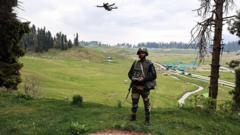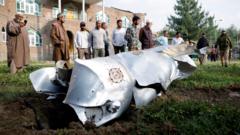### Summary: The alarming shift towards drone warfare between India and Pakistan introduces new dynamics in their conflict, as both nations trade aerial strikes and denials amid rising tensions. With international calls for restraint, experts fear that these unmanned systems could either de-escalate or ignite further violence in a region already fraught with hostilities.
### Title: Escalating Tensions: Unmanned Warfare Begins Between India and Pakistan

### Title: Escalating Tensions: Unmanned Warfare Begins Between India and Pakistan
### Description: Recent drone exchanges signal a new phase in the decades-long conflict between India and Pakistan, raising concerns about a potential escalation in hostilities.
In a notable twist in ongoing hostilities, India and Pakistan have entered an era of drone warfare, marking the world's first armed conflict between two nuclear powers employing unmanned aerial vehicles on such a scale. On Thursday, the Indian military accused Pakistan of launching multiple drone and missile attacks against three military installations before Indian-administered Kashmir, a claim that Islamabad quickly refuted. In retaliation, Pakistan asserted that it had neutralized 25 Indian drones, leading to a tense exchange reflective of a deeper, more dangerous phase in their longstanding rivalry.
Experts warn that this shift toward drone warfare complicates an already volatile scenario, as both countries resort not only to traditional artillery but also to silent and remote-controlled systems that could redefine warfare in the region. According to Jahara Matisek, a professor at the U.S. Naval War College, the competition for drone superiority expands the battleground into the skies, where the ability to control unmanned technology can significantly influence outcomes.
Casualty reports have emerged from both sides, with Pakistan blaming Indian strikes for killing 36 individuals, while India reported at least 16 civilian deaths due to Pakistani shelling. India’s military contends that its actions were direct reprisals for a recent militant attack, a situation compounded by intermittent exchanges of fire across the contested border.
The nature of modern warfare heavily leans on the capabilities of drones, which today play multifaceted roles that extend beyond weaponry; they act as scouts, target identifiers, and as means to disrupt enemy defenses. This trend is noted on both sides: Indian forces utilize largely Israeli-made systems known for precision and endurance, while Pakistan boasts a diverse inventory of drones sourced from China and Turkey, indicative of a continuing arms race.
Pakistan's air force, actively developing drone strategies since the past decade, employs "loyal wingman" drones that work in coordination with traditional combat aircraft, underscoring a tactical shift in operational strategy. On the contrary, India's recent acquisition of advanced drones from the U.S. represents a formidable enhancement of its aerial capabilities.
While current aerial exchanges between India and Pakistan are limited when compared to the extensive drone engagements in the Ukraine war, analysts caution that they might be reflective of a broader escalation. Manoj Joshi, an Indian defense analyst, warned that the impact of these engagements depends on whether they escalate into a full-fledged aerial campaign, or if they ultimately lead to a sustainable de-escalation.
Both countries appear to be cautiously probing one another, with each drone shot potentially inflating tensions in an already delicate environment. As the specter of nuclear confrontation looms, the international community watches closely, urging restraint and warning of the unpredictability that drone warfare may introduce to their complex geopolitical landscape. Ultimately, the trajectory of conflict in this nuclear flashpoint remains to be seen, with both de-escalation and escalation as viable outcomes.


















